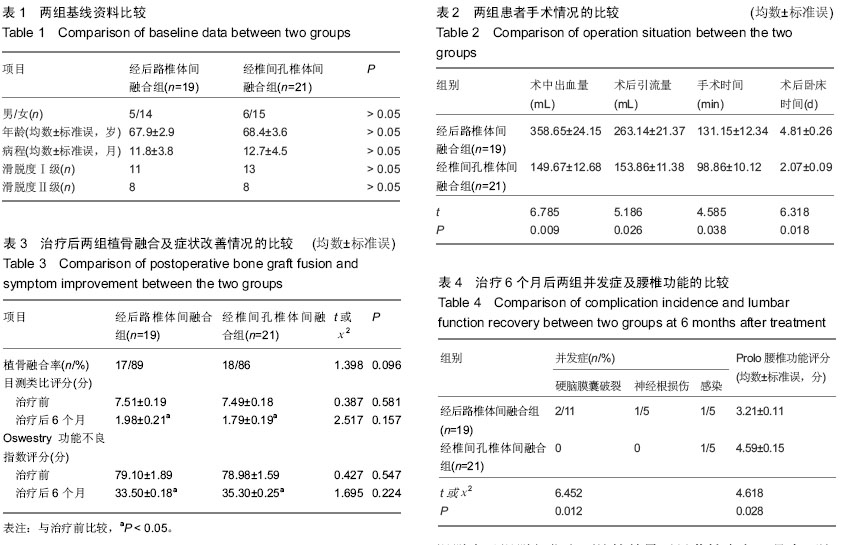| [1]Salin K,Soroush MH,Peter CC,et al.Cost-utility of lumbar decompression with or without fusion for patients with symptomatic degenerative lumbar spondylolisthesis. Spine J.2012;12(1):44-54.
[2] Sabarul AM,Peter FM,Owen DW,et al.Health-related quality of life:a comparison of outcomes after lumbar fusion for degenerative spondylolisthesis with large joint replacement surgery and population norms.Spine J.2010;10(4):306-312.
[3] 何健.不同手术方案治疗退变性腰椎管狭窄症患者的疗效对比[J].河北医药,2015,37(4):539-541.
[4] 潘明芒,薛锋.轻中度退变性腰椎管狭窄症的治疗选择[J].中国骨与关节损伤杂志,2011,21(6):480-484.
[5] 罗斌,梅锦荣,王国荣,等.单纯PLIF与PLIF联合PLF治疗腰椎退行性疾病的临床效果对比研究[J].中国现代医生,2013,51(28): 28-30.
[6] 陈建华,王盛海,杨波,等.改良TLIF 治疗退变性腰椎滑脱并椎管狭窄症[J].中国骨与关节损伤杂志,2012,27(3):248-249.
[7] 刘锐.不同手术方法治疗老年退变性腰椎滑脱合并腰椎管狭窄症疗效的比较[J].北方药业,2011,9(8):52-53.
[8] 徐新华,胡家美.不同手术方法治疗老年退变性腰椎滑脱合并腰椎管狭窄症的临床对比分析[J].中国当代医药,2012,19(36): 47-48.
[9] Takahashi J,Kobayashi H,Wakabayashi S,et al.The effect of a prostaglandin E1 derivative on the symptoms and quality of life of patients with lumbar spinal stenosis.J Orthop Sci.2013; 18(2):208-215.
[10] 魏煊,赵娜如,林泽枫,等.可控孔隙结构三维多孔β-磷酸三钙支架的制备与表征[J].功能材料,2012,23(43):3217-3221.
[11] 侯喜君.β磷酸三钙/a半水硫酸钙复合人工骨的实验研究[D]. 中国人民解放军军医进修学院,2007:85.
[12] 许宋锋,徐明,于秀淳,等.多孔磷酸三钙修复腔隙性骨缺损38例随访研究[J].中国骨与关节杂志,2014,3(4):282-286.
[13] Sakaura H,Yamashita T,Miwa T,et al.Outcomes of 2-level posterior lumbar interbody fusion for 2-level degenerative lumbar spondylolisthesis.J Neurosurg Spine.2013;19(1): 90-94.
[14] 付开封.腰椎后路减压、椎间融合器植骨融合、钉棒系统内固定术治疗腰椎滑脱症的临床效果分析[D].山东大学,2013.
[15] 赵枫,邓潇,康宝林.成人轻度峡部裂型腰椎滑脱的治疗分析[J].中国骨与关节损伤杂志,2013,28(5):485-489.
[16] 陈是煌,郭志宏,陈伟.PLIF结合椎弓根内固定和PEEKcage治疗腰椎滑脱的临床疗效[J].江苏医药,2011,7(14):6177-6179.
[17] 陈志强,林健泽.手术治疗老年退变性腰椎滑脱合并腰椎管狭窄症62例临床分析[J].中国医学创新,2013,10(29):44-45.
[18] 徐新华,胡家美.不同手术方法治疗老年退变性腰椎滑脱合并腰椎管狭窄症的临床对比分析[J].中国当代医药,2012,19(36): 47-48.
[19] 马辉,李忠海,朱晓东,等.腰椎椎间融合术与动态固定术治疗腰椎退行性疾病的临床评价[J].脊柱外科杂志,2011,9(4):226-231.
[20] 陈志强,林健泽.手术治疗老年退变性腰椎滑脱合并腰椎管狭窄症62例临床分析[J].中国医学创新,2013,10(29):44-45.
[21] 刘星刚,邓旭亮,邹超,等.多孔β-磷酸三钙/胶原支架修复兔下颌牙槽骨缺损的实验研究[J].北京口腔医学,2014,22(1):1-4.
[22] 王军琳,朱皓东,马许宁,等.整体填充和颗粒填充β-TCP植骨材料对修复腔隙性骨缺损的影响[J].现代生物医学进展,2013, 13(9): 1648-1650.
[23] 殷建华,张胜林,徐信龙.后路椎弓根钉内固定加椎间融合器植骨融合治疗腰椎滑脱[J]. 江苏医药,2012,38(24):3027-3028.
[24] 王鹏飞,谢威,王民洁.PLIF与TLIF治疗老年退变性腰椎滑脱合并腰椎管狭窄症的疗效比较[J].重庆医学,2014,43(10): 1259- 1261.
[25] 吕廷灼,王文志,冯世庆.腰椎融合术的治疗进展[J].中国矫形外科杂志,2011,19(9):747-749.
[26] 朱建炜,刘璠,张烽,等.腰椎间孔入路腰椎体间植骨融合结合椎弓根螺钉置入内固定:能提高退行性病变腰椎的稳定性与植骨融合率吗?[J].中国组织工程研究与临床康复,2010,14(13): 2425- 2428. |
